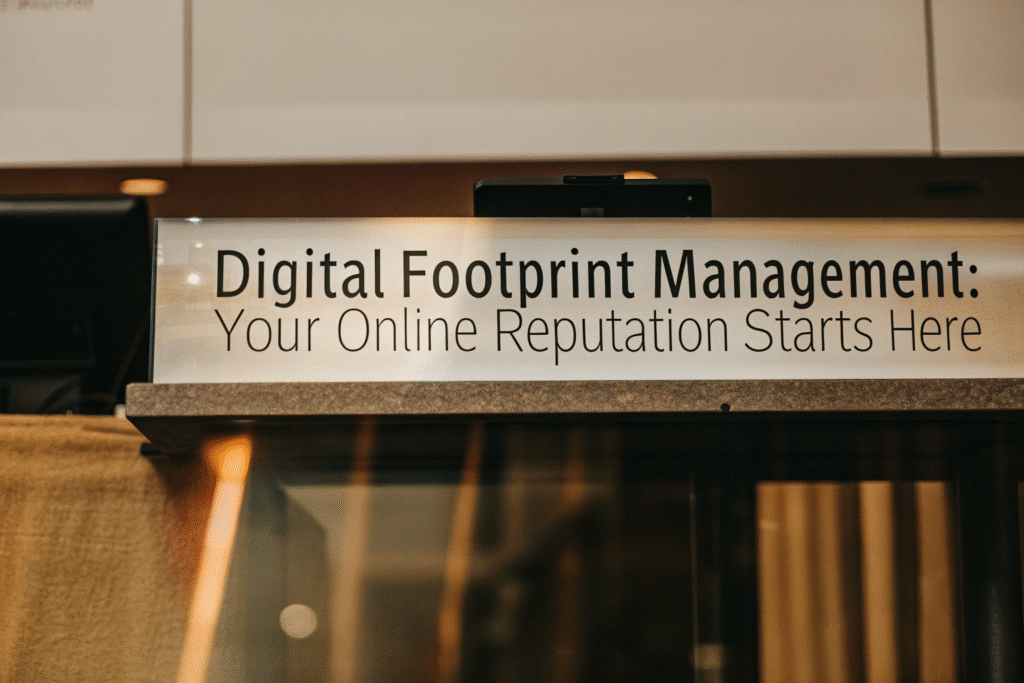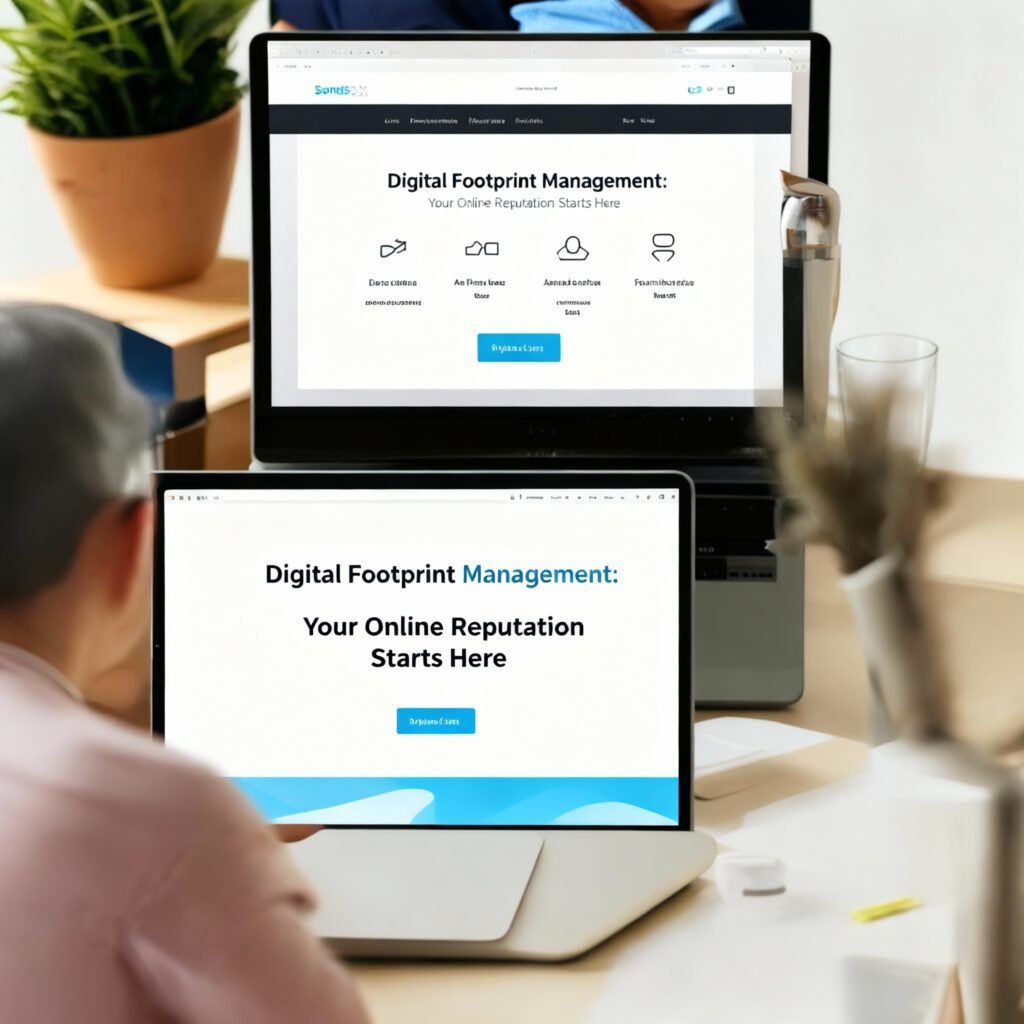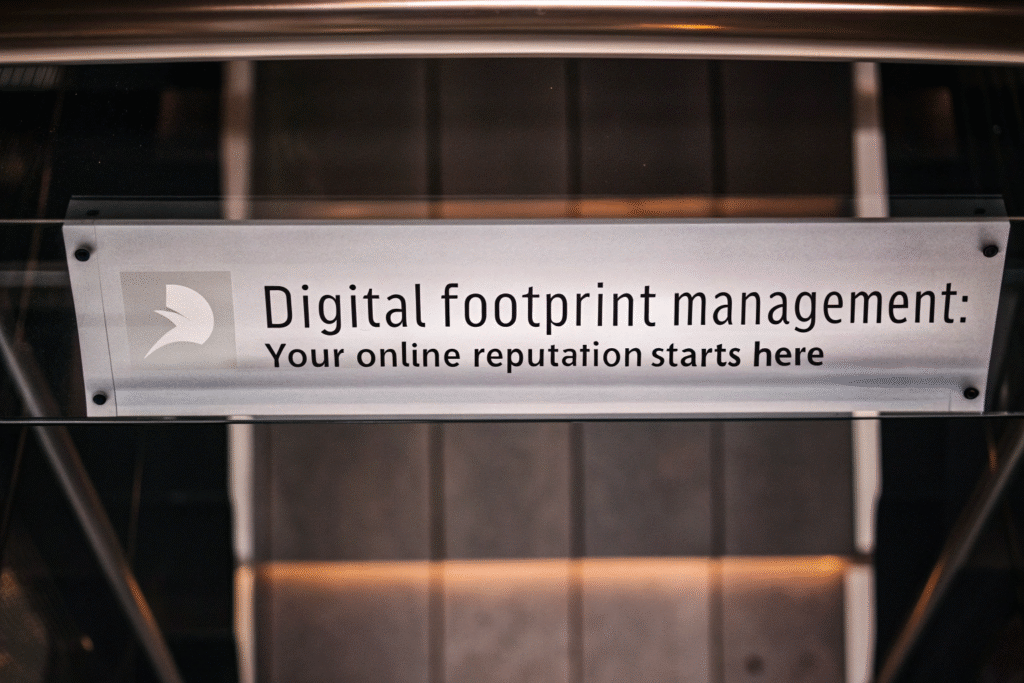
Digital Footprint Management: Every click, comment, share, and search you make online leaves a trace. Together, these traces form your digital footprint—a permanent record of your online existence that can either open doors or slam them shut.
Think about the last time you hired someone or chose a service provider. Chances are, you googled them first. That’s exactly what potential clients, employers, and business partners are doing to you right now. What they find in those critical first seconds can make or break opportunities before you even know they existed.
Digital footprint management isn’t about hiding who you are—it’s about intentionally shaping how the world sees you online. Whether you’re building a personal brand, growing a business, or simply protecting your professional reputation, understanding and managing your digital presence has become as essential as having a resume.
In this comprehensive guide, you’ll discover how to take control of your online identity and turn it into your most powerful marketing asset.
Table of Contents
- Introduction
- History & Evolution
- Audience & Demographics
- Key Features & Functions
- Business & Marketing Potential
- Best Practices & Tips
- Challenges & Limitations
- Future Outlook
- Conclusion
History & Evolution
From Anonymous to Accountable
The concept of digital footprint management emerged in the early 2000s as social media platforms started preserving user content indefinitely. Initially, most people treated the internet as a temporary space where content would eventually disappear into the digital void.
That all changed when employers started screening candidates through social media searches. Suddenly, those party photos from college had professional consequences. The phrase “the internet never forgets” became a cautionary tale rather than a joke.
The Professional Awakening
By 2010, personal branding experts recognized that digital footprints could be assets rather than just liabilities. Forward-thinking professionals began intentionally crafting their online presence to showcase expertise and build credibility.
The shift accelerated dramatically with the rise of the gig economy and remote work. Freelancers and entrepreneurs realized their digital footprint often served as their only resume, portfolio, and sales pitch rolled into one.
Today, digital footprint management has evolved from damage control into strategic brand building. It’s no longer just about removing embarrassing content—it’s about creating a cohesive online identity that attracts opportunities and builds trust.
Audience & Demographics
Who Needs Digital Footprint Management?
The short answer? Everyone. However, certain groups have more at stake:
Job Seekers and Career Professionals
With 70% of employers screening candidates online, your digital footprint often determines whether you get an interview. A single controversial tweet or unprofessional photo can eliminate you from consideration before anyone reads your resume.
Entrepreneurs and Business Owners
Your personal brand directly impacts your business reputation. Customers research founders before buying products. Investors investigate entrepreneurs before writing checks. Your digital footprint is your business card, portfolio, and credibility statement combined.
Freelancers and Content Creators
When you are the product, your digital footprint becomes your storefront. Potential clients judge your expertise, professionalism, and reliability based entirely on what they find about you online.
Digital Marketers and Social Media Managers
You can’t effectively manage others’ online presence without mastering your own. Your digital footprint serves as proof of your expertise in the field.
Students and Recent Graduates
Building a positive digital footprint early creates opportunities throughout your career. What you post today follows you for decades.
Key Features & Functions
Understanding the Two Types of Digital Footprints
Active Digital Footprints
These are traces you leave intentionally. Every social media post, blog comment, forum contribution, and online review you write creates an active footprint. You have direct control over this content when you create it.
Examples include:
- LinkedIn posts and profile updates
- Twitter threads sharing your expertise
- Blog articles under your name
- YouTube videos featuring your content
- Professional portfolio websites
Passive Digital Footprints
These form without your direct action. They include data collected about your browsing habits, IP address logs, location tracking, and information others post about you.
Examples include:
- Photos others tag you in
- Reviews customers write about your business
- News articles mentioning your name
- Company directories listing your information
- Third-party website analytics tracking your visits
Components of Effective Management
Successful digital footprint management involves three core functions:
Monitoring
Regularly tracking what appears when someone searches your name or business. This includes social media mentions, news coverage, reviews, and any content featuring you.
Optimization
Strategically creating and promoting positive content that appears in search results. This pushes down negative or irrelevant information while highlighting your best qualities.
Protection
Implementing privacy settings, removing harmful content when possible, and preventing future reputation damage through smart online behavior.
Business & Marketing Potential
Turning Footprints into Fortune
A well-managed digital footprint directly translates into business opportunities. Here’s how it impacts your bottom line:
Enhanced Credibility and Trust
When potential clients research you and find consistent, professional content showcasing your expertise, they’re far more likely to choose your services. A strong digital footprint reduces the perceived risk of working with you.
Improved SEO and Visibility
Active management of your digital footprint naturally improves your search engine rankings. When you dominate the first page of search results with positive content, you control the narrative about your brand.
Lead Generation on Autopilot
A robust digital footprint works 24/7 attracting prospects. Blog posts you wrote years ago continue generating leads. Old podcast interviews keep introducing new people to your expertise.
Premium Pricing Power
Professionals with strong digital footprints command higher fees. When your online presence demonstrates expertise and authority, clients perceive greater value in your services.
Partnership Opportunities
Other businesses evaluate potential partners through digital footprint analysis. A professional, impressive online presence opens doors to collaborations, speaking engagements, and joint ventures.
Competitive Advantage
While competitors neglect their digital presence, your well-managed footprint positions you as the obvious choice. In crowded markets, this differentiation becomes your secret weapon.

Best Practices & Tips
Taking Control of Your Digital Presence
Conduct a Digital Audit
Start by googling yourself. Use different search engines and try variations of your name. Check what appears on the first three pages of results. Also search your business name, key social profiles, and any usernames you regularly use.
Claim Your Name Everywhere
Register your name as a domain and create profiles on major platforms even if you don’t plan to use them immediately. This prevents others from claiming your identity and gives you control over those search results.
Create Positive Content Consistently
Publish valuable content regularly under your name. Blog posts, LinkedIn articles, YouTube videos, and podcast appearances push down negative content while building your authority.
Optimize Your Social Profiles
Ensure all professional social media profiles present a consistent brand message. Use the same professional photo, similar bios, and aligned positioning across platforms.
Monitor Your Name with Alerts
Set up Google Alerts for your name, business name, and key variations. This notifies you immediately when new content appears, allowing quick response to potential issues.
Engage Professionally and Authentically
Every comment, reply, and interaction contributes to your digital footprint. Be helpful, professional, and genuine in all online communications.
Request Removal of Harmful Content
Contact website administrators to remove false or defamatory content. While not always successful, many sites will remove inaccurate information upon request.
Build a Personal Website
A professional website showcasing your expertise typically ranks highly for your name. This gives you control over what people see first when they search for you.
Leverage Privacy Settings Strategically
Review privacy settings on all platforms. Make personal accounts private while keeping professional profiles public and polished.
Think Before You Post
Apply the “grandmother test” before posting anything. If you wouldn’t want your grandmother, boss, or potential client seeing it, don’t post it.
Challenges & Limitations
The Reality of Digital Footprint Management
Managing your digital footprint isn’t always straightforward. Several challenges complicate the process:
The Right to Be Forgotten Limitations
While some regions have laws allowing content removal, enforcement remains inconsistent. Many websites refuse removal requests, and US law generally favors free speech over privacy.
Content You Don’t Control
You can’t delete everything. Reviews, news articles, public records, and content others post about you often stay online regardless of your preferences.
Time and Resource Investment
Effective digital footprint management requires ongoing effort. Creating positive content, monitoring mentions, and maintaining profiles demands significant time commitment.
Algorithm Changes
Search engine algorithms constantly evolve. Content that once appeared on page one might suddenly drop to page three, requiring continuous optimization.
Authenticity vs. Control Tension
Overpolishing your online presence can make you seem inauthentic. Finding the balance between control and genuine expression challenges many professionals.
Legacy Content Issues
Comments and posts from years ago don’t disappear. That controversial opinion you shared five years ago can resurface unexpectedly.
Future Outlook
What’s Coming in Digital Identity Management
The future of digital footprint management is evolving rapidly with technological advancement and changing social norms.
AI-Powered Reputation Tools
Artificial intelligence is revolutionizing how we monitor and manage digital footprints. AI tools can now scan millions of web pages instantly, identify reputation threats, and even suggest optimal content strategies.
Blockchain Identity Verification
Blockchain technology promises to give individuals greater control over their digital identity. Decentralized identity systems may allow you to own and manage all your online data directly.
Increased Privacy Regulations
More countries are implementing GDPR-style privacy laws giving individuals greater rights over their digital footprints. This trend will likely continue, providing more tools for managing online information.
Visual and Voice Search Impact
As image and voice search grow, digital footprint management must expand beyond text. Photos, videos, and audio content become increasingly important in reputation management.
Deepfake Challenges
Unfortunately, fake videos and manipulated content pose new reputation threats. Future digital footprint management will need to include proactive verification systems proving content authenticity.

Conclusion: Your Digital Legacy Awaits
Your digital footprint isn’t going anywhere—it will only grow larger and more influential over time. The question isn’t whether you have a digital presence but whether you’re actively shaping it or letting it form by accident.
Every day you delay managing your digital footprint, you lose opportunities. Potential clients choose competitors with stronger online presence. Job recruiters pass over your application because your social media doesn’t align with your resume. Business partners question your professionalism based on old, forgotten content.
But here’s the good news: starting today, you can transform your digital footprint from a liability into your most powerful marketing tool. Begin with a simple audit. Google yourself. Review what appears. Then commit to adding one piece of positive, professional content each week.
Your action plan starts now:
- Schedule 30 minutes this week to audit your current digital footprint
- Claim your name on major platforms you haven’t joined yet
- Create or update your LinkedIn profile with your latest achievements
- Write one blog post or article sharing your expertise
Remember, your digital footprint is your 24/7 representative in the online world. Make sure it’s telling the story you want people to hear. The internet never sleeps, and neither does your reputation. Take control today, and watch opportunities find their way to you.
Your future self will thank you for the digital legacy you start building right now.